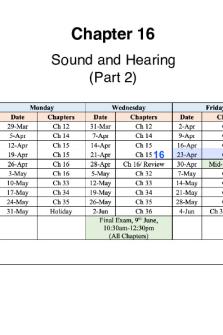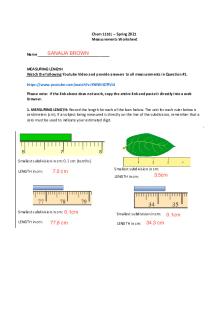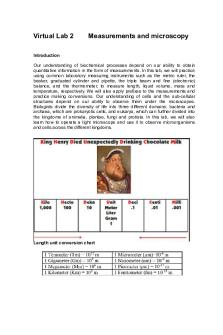CHE 121 Chapter 2 Chemistry and Measurements Part 2 PDF

| Title | CHE 121 Chapter 2 Chemistry and Measurements Part 2 |
|---|---|
| Course | College Chemistry II |
| Institution | Borough of Manhattan Community College |
| Pages | 4 |
| File Size | 96.1 KB |
| File Type | |
| Total Downloads | 22 |
| Total Views | 147 |
Summary
Lecture Notes Chemestry 121 BMCC. Prof. Aireen Romu.
In addition, some exercises viewed and corrected during class hours....
Description
CHEMISTRY 121:
Chapter 2: Chemistry and Measurements Part 2
2.4 Prefixes and Equalities A special feature of the SI as well as the metric system is that a prefix can be placed in front of any unit to increase or decrease its size by some factor of ten. For example, the prefixes milli and micro are used to make the smaller units. milligram (mg) microgram (μg or mcg)
The relationship of a prefix to a unit can be expressed by replacing the prefix with its numerical value. • For example, when the prefix kilo in kilometer is replaced with its value of 1000, we find that a kilometer is equal to 1000 meters. kilometer = 1000 meters (103 m) kiloliter = 1000 liters (103 L) kilogram = 1000 grams (103 g)
2.5 Writing Conversion Factors In the United States, the contents of many packaged foods are listed in both U.S. and metric units. Equalities use two different units to describe the same measured amount. are written for relationships between units of the metric system, U.S. units, or between metric and U.S. units. For example,
1 m = 1000 mm (103 mm) 1 lb = 16 oz 2.20 lb = 1 kg
Any equality can be written as conversion factors. Conversion Factors for the Equality 60 min = 1 h Equalities: Conversion Factors and SF The numbers in any equality between two metric units between two U.S. system units are obtained by definition and are, therefore, exact numbers. a definition are exact and are not used to determine significant figures. an equality between metric and U.S. units contain one number obtained by measurement and count toward the significant figures. Exception: The equality 1 in. = 2.54 cm has been defined as an exact relationship. Therefore, 2.54 is an exact number.
Metric Conversion Factors 1m = 100 cm 100 cm / 1m and 1 m/100 cm
We can write metric–U.S. system conversion factors. 1kg = 2.20 lb In the United States, the contents of many packaged foods are listed in both U.S. and metric units.
2.6 Problem Solving Using Unit Conversion Exercising regularly helps reduce body fat
Guide to Problem Solving Using Unit Conversion The process of problem solving in chemistry often requires one or more conversion factors to change a given unit to the needed unit. Problem solving in chemistry requires: Identification of the given quantity units. Determination of the units needed. Identification of conversion factors that connect the given and needed units.
Steps for solving problems that contain unit conversions include the following: STEP 1 State the given and needed quantities. STEP 2 Write a plan to convert the given unit to the needed unit. STEP 3 State the equalities and conversion factors STEP 4 Set up the problem to cancel units and calculate the answer.
Using Two or More Conversion Factors In problem solving, Two or more conversion factors are often needed to complete the change of units. In setting up these problems, one factor follows the other. Each factor is arranged to cancel the preceding unit until the needed unit is obtained.
2.7 Density Learning Goal Calculate the density of a substance; use the density to calculate the mass or volume of a substance.
Objects that sink in water are more dense than water; objects that float are less dense.
Density compares the mass of an object to its volume. The density of a solid can be determined by dividing the mass of an object by its volume.
Density Using Volume Displacement The density of the solid zinc object is calculated by dividing its mass by its displaced volume. To determine its displaced volume, submerge the solid in water so that it displaces water that is equal to its own volume. 45.0 mL − 35.5 mL = 9.5 mL = 9.5 cm3 Density calculation: Density zinc = (mass of zinc) 68.60 g / (volume of zinc) 9.5 cm^3 = 7.2 g/cm^3
Problem Solving Using Density
STEP 1 State the given and needed quantities. STEP 2 Write a plan to calculate the needed quantity. STEP 3 Write the equalities and their conversion factors, including density. STEP 4 Set up the problem to calculate the needed quantity....
Similar Free PDFs

General Chemistry chapter 2
- 5 Pages

Chapter 2 - Chemistry Notes
- 10 Pages

CHE-121 Written Assignment 3
- 3 Pages

CHE-121 Written Assignment 7
- 5 Pages

Chapter 16 Part 2
- 27 Pages

Chemistry Lab 1 Measurements
- 5 Pages

Chapter 6 part 2
- 1 Pages

Chapter 1 Part 2
- 3 Pages

Chapter 2 Part 2 Learning Guide
- 10 Pages
Popular Institutions
- Tinajero National High School - Annex
- Politeknik Caltex Riau
- Yokohama City University
- SGT University
- University of Al-Qadisiyah
- Divine Word College of Vigan
- Techniek College Rotterdam
- Universidade de Santiago
- Universiti Teknologi MARA Cawangan Johor Kampus Pasir Gudang
- Poltekkes Kemenkes Yogyakarta
- Baguio City National High School
- Colegio san marcos
- preparatoria uno
- Centro de Bachillerato Tecnológico Industrial y de Servicios No. 107
- Dalian Maritime University
- Quang Trung Secondary School
- Colegio Tecnológico en Informática
- Corporación Regional de Educación Superior
- Grupo CEDVA
- Dar Al Uloom University
- Centro de Estudios Preuniversitarios de la Universidad Nacional de Ingeniería
- 上智大学
- Aakash International School, Nuna Majara
- San Felipe Neri Catholic School
- Kang Chiao International School - New Taipei City
- Misamis Occidental National High School
- Institución Educativa Escuela Normal Juan Ladrilleros
- Kolehiyo ng Pantukan
- Batanes State College
- Instituto Continental
- Sekolah Menengah Kejuruan Kesehatan Kaltara (Tarakan)
- Colegio de La Inmaculada Concepcion - Cebu






